Leroy C., Rancoita P.-G. Principles Of Radiation Interaction In Matter And Detection
Подождите немного. Документ загружается.

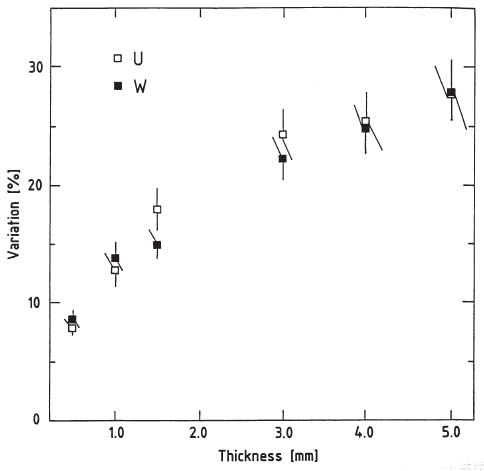
January 9, 2009 10:21 World Scientific Book - 9.75in x 6.5in ws-bo ok975x65˙n˙2nd˙Ed
630 Principles of Radiation Interaction in Matter and Detection
Fig. 9.6 Reduction in percentage of the electromagnetic visible-energy, measured with Si/U and
Si/W calorimeters, expressed as ∆ ²/²[%] = 100[²
vis
(no G10) − ²
vis
(G10)]/²
vis
(no G10) versus the
G10 plate thickness inserted at the rear of the silicon readout detectors (from [Leroy and Rancoita
(2000)], see also [SICAPO Collab. (1989b)]).
The local hardening effect requires thin (in units of radiation length) low-Z
absorbers. If their thickness is increased so much that they start to become part of
the shower generation process, the e/mip ratio will increase again as indicated by
EGS4 simulations [Wigmans (1988)] and the experimental data of Fig. 9.6. In fact,
the data show an approximate logarithmic increase of ∆²/² with the G10 thickness,
while [Eq. (9.4)] the value of 1/E
s
is linearly increasing with the G10 thickness.
A further reduction of the e/mip ratio is achievable by inserting low-Z plates
both behind and in front of readout detectors. The effect was also observed,
when different low-Z absorbers (like polyethylene and aluminum) [SICAPO Col-
lab. (1992b)] are employed.
The extent to which the reduction in the e/mip ratio can be achieved dep ends
on the readout layer thickness in g/cm
2
. As the readout layers thickness increases,
the maximum reduction achievable decreases, for instance we have e/mip(0.5 mm
Fe) ≈ 0.92 e/mip(noFe) using scintillator readout plates 2.6 mm thick in a uranium
(uranium plates wrapped in stainless steel) sampling calorimeter [Wigmans (1988)].
Although the lo cal hardening effect largely reduces the e/mip ratio in calorime-
ters employing high-Z media, it was also observed when medium-Z passive samplers
(like Fe) were used [SICAPO Collab. (1993b)]. However, as predicted, the effect is
smaller. In an iron calorimeter (with 30 mm-thick passive samplers), the visible
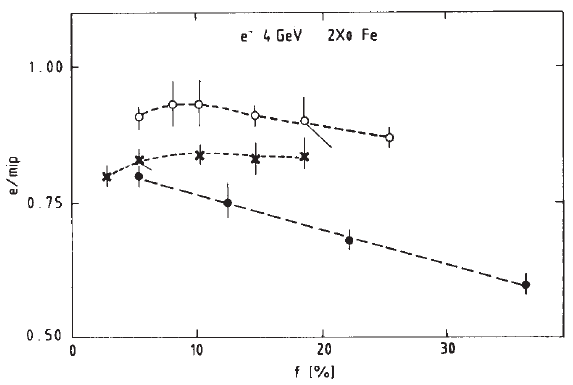
January 9, 2009 10:21 World Scientific Book - 9.75in x 6.5in ws-bo ok975x65˙n˙2nd˙Ed
Principles of Particle Energy Determination 631
energy is reduced by ≈ 8%, while E
s
is reduced by ≈ 1.2% when plexiglas layers
(1.6 mm in front of and 0.8 mm behind the silicon readout detectors) are introduced.
9.3 Principles of Calorimetry with Complex Absorbers
For complex absorbers we mean a set of media with large differences in their critical
energies and with thicknesses, which are non-negligible for the process of shower
generation. These absorbers can be used as passive samplers in sampling calorimetry.
We have seen how, in the generation and propagation process of a shower in com-
plex absorbers, low-energy photons lead to the generation of low-energy electrons
by Compton and photoelectric effects, which have a different Z dependence. This
Z-dependence explains the differential attenuation of radiation in absorbers. Most
of these generated low-energy electrons are generally absorbed before they reach
the readout medium. Thus, a significant change in the soft-energy deposition can
be expected if materials with large differences among their critical-energy values,
i.e., with large difference in Z
absorber
values, are set in sequence in the complex
absorber sampler.
Fig. 9.7 e/mip as a function of the Pb fraction, f , in the passive sampler in various calorimeter
configurations measured using 4 GeV electrons: Pb+Fe+Pb [sandwich configuration (◦)], Fe+Pb
[F-configuration (×)] and Pb+Fe [R-configuration (•)] (reprinted from Phys. Lett. B 222, Borchi,
E. et al., Electromagnetic shower energy filtering effect. A way to achieve the compensation con-
dition (e/π=1) in hadronic calorimetry, 525–532, Copyright (1989), with permission from Else-
vier, e.g, for the list of the authors see [SICAPO Collab. (1989c)]; see also [Leroy and Rancoita
(2000)]). In these configurations, the thickness of the Fe absorber in each passive sampler was
corresponding to 1.99 X
0
. The lines are to guide the eye.
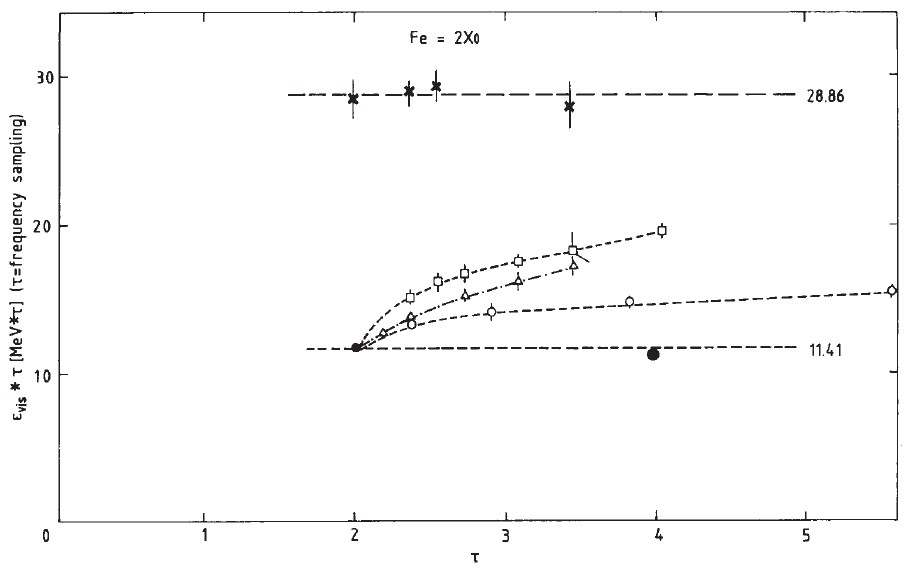
January 9, 2009 10:21 World Scientific Book - 9.75in x 6.5in ws-bo ok975x65˙n˙2nd˙Ed
632 Principles of Radiation Interaction in Matter and Detection
Fig. 9.8 ²
vis
τ in MeV τ as a function of the sampling frequency τ in various calorimeter configurations measured using 4 GeV electrons: Pb+Fe+Pb
[sandwich configuration (2)], Fe+Pb [F-configuration (4)] and Pb+Fe [R-configuration (◦)] (reprinted from Phys. Lett. B 222, Borchi, E. et al.,
Electromagnetic shower energy filtering effect. A way to achieve the compensation condition (e/π =1) in hadronic calorimetry, 525–532, Copyright
(1989), with permission from Elsevier, e.g, for the list of the authors see [SICAPO Collab. (1989c)]; see also [Leroy and Rancoita (2000)]). In the
above configurations, the thickness of the Fe absorber in each passive sampler was corresponding to 1.99 X
0
. The configuration with Pb (×) and Fe
(•) absorbers alone are also shown. The lines are to guide the eye.
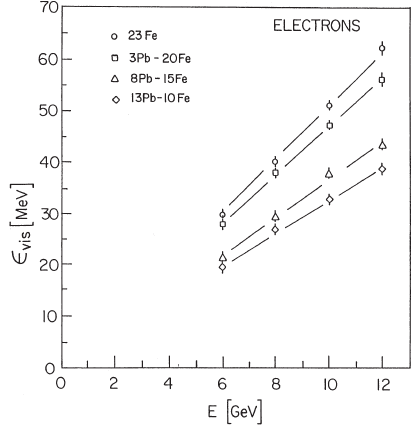
January 9, 2009 10:21 World Scientific Book - 9.75in x 6.5in ws-bo ok975x65˙n˙2nd˙Ed
Principles of Particle Energy Determination 633
Fig. 9.9 Mean energy deposited by electrons in the Si/(Fe,Pb) calorimeter as a function of the
incoming energy (reprinted from Nucl. Instr. and Meth. in Phys. Res. A 332, Borchi, E.
et al., Systematic investigation of the electromagnetic filtering effect as a tool for achieving the
compensation condition in silicon hadron calorimetry, 85–90, Copyright (1993), with permission
from Elsevier, e.g, for the list of the authors see [SICAPO Collab. (1993b)]; see also [Leroy and
Rancoita (2000)]). The sampling thickness is 23 mm. The top points correspond to the case where
there is no Pb in the absorber. The other points correspond to configurations where the thickness of
Pb in the PbFe–Si–PbFe absorber configuration is (from top to bottom) 3.0, 8.0, and 13.0 mm. The
lines are to guide the eye.
In general, when complex absorbers are employed the energy deposition rate will
change because the shower composed of charged particles and photons generated in a
medium has to deposit its energy according to the stopping power and the attenuation
length of another material. It can be concluded, as seen on page 214, that the
process of shower energy deposition is affected by the sequence of absorbers. As a
consequence, the e/mip ratio also varies depending on the sequence of the absorbers,
when a complex absorber is employed. However, an additional slight variation may
be expected as a function of the type and thickness of the readout detector. This
phenomenon was experimentally observed and referred to as the electromagnetic
shower energy filtering effect [SICAPO Collab. (1989c)].
It has to be emphasized that low-energy phenomena, i.e., the energy loss of
electrons and positrons close to the critical energy and soft-photon interactions
by Compton or photoelectric effects, are the main processes of shower energy de-
position. While interactions by soft electrons and positrons were considered in an
approximate way, the full complexity of low-energy photon interactions was not
taken into account at all in the framework of “Approximation B”. Consequently, as
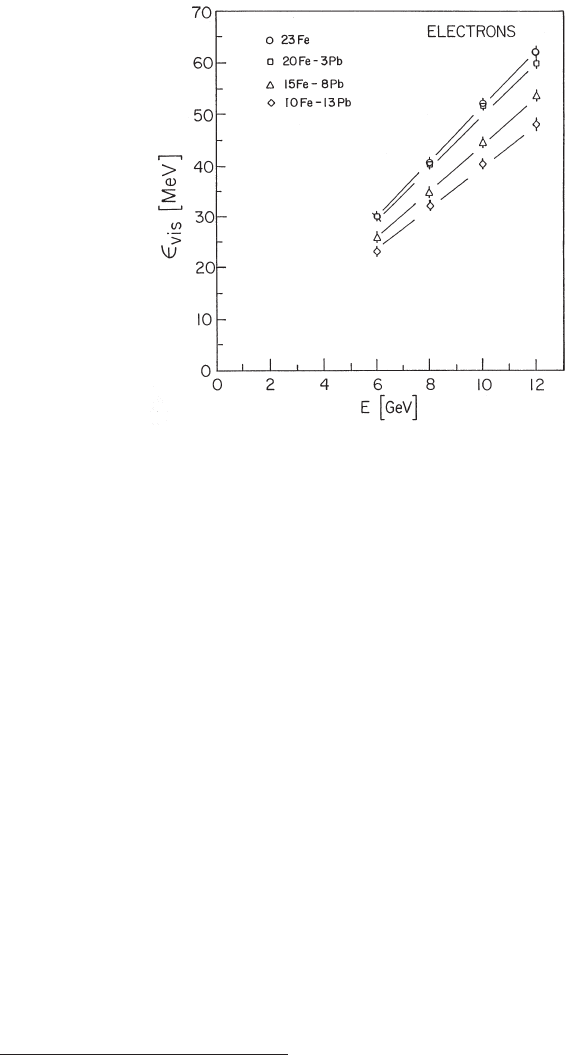
January 9, 2009 10:21 World Scientific Book - 9.75in x 6.5in ws-bo ok975x65˙n˙2nd˙Ed
634 Principles of Radiation Interaction in Matter and Detection
Fig. 9.10 Mean energy deposited by electrons in the Si/(Fe,Pb) calorimeter as a function of the
incoming energy (reprinted from Nucl. Instr. and Meth. in Phys. Res. A 332, Borchi, E.
et al., Systematic investigation of the electromagnetic filtering effect as a tool for achieving the
compensation condition in silicon hadron calorimetry, 85–90, Copyright (1993), with permission
from Elsevier, e.g, for the list of the authors see [SICAPO Collab. (1993b)]; see also [Leroy and
Rancoita (2000)]). The sampling thickness is 23 mm. The top points correspond to the case where
there is no Pb in the absorber. The other points correspond to configurations where the thickness of
Pb in the FePb–Si–FePb absorber configuration is (from top to bottom) 3.0, 8.0, and 13.0 mm. The
lines are to guide the eye.
remarked on page 623, the transition effect introduced by Pinkau does not play any
effective role in explaining the behavior of the visible energy and the e/mip ratio
for a sampling calorimeter with complex absorbers.
9.3.1 The Filtering Effect and how to tune the e/mip Ratio
The reduction of the e/mip ratio as the result of the reduction of the electromag-
netic visible-energy in a sampling calorimeter was experimentally observed using
both Fe and Pb plates as passive samplers and silicon detectors as active read-
out media [SICAPO Collab. (1989c)]. The e/mip ratios of three passive sampler
configurations
∗
along the shower axis were investigated: Fe+Pb (F-configuration),
Pb+Fe (R-configuration) and Pb+Fe+Pb (sandwich configuration). They are shown
∗
In these configurations, the thickness of the Fe absorber in each passive sampler was correspon-
ding to 1.99 X
0
.

January 9, 2009 10:21 World Scientific Book - 9.75in x 6.5in ws-bo ok975x65˙n˙2nd˙Ed
Principles of Particle Energy Determination 635
in Fig. 9.7 as function of the Pb absorber fraction (f) in the passive sampler, with
f =
L
P b
L
P b
+ L
F e
, (9.14)
where L
F e
and L
P b
are the thicknesses of Fe and Pb absorbers, respectively. Data
were also taken with Fe and Pb plates alone (as passive samplers): in Fig. 9.8
the corresponding values of the visible energies (²
vis
) multiplied by the sampling
frequency (τ), measured using 4 GeV electrons, are shown as function of τ . For
f & 5%, the e/mip ratios resulted to be
e/mip (Pb+Fe+Pb) > e/mip (Fe+Pb) > e/mip (Pb+Fe).
Furthermore, a strong evidence of anomalous energy deposition during the shower
propagation was obtained by the measurements of e/mip ratios for Fe alone, Pb
alone and a R-configuration, in which the Pb absorber was a fraction
f ≈ 36%
of the total Pb+Fe length (= L
P b
+ L
F e
); the e/mip ratios found were 0.78±0.02,
0.69±0.04, and 0.60±0.02, respectively. These measurements indicate that, using
Pb and Fe absorbers together (Fe+Pb), the e/mip value is lower than the cor-
responding values obtained, when Fe and Pb absorbers are used alone [SICAPO
Collab. (1989c)]. Furthermore for the R-configuration, the measured e/mip ratio
was found to decrease linearly with the increase of the Pb fraction f (Fig. 9.7).
The visible-energy variation was also experimentally observed, when scintillators
were used as the readout medium. The SDC calorimeter group has carried out
measurements using the so-called Hanging-File Calorimeter, in which scintillator
plates were read out by wavelength shifting fibers [Beretvas et al. (1993)]. Two of
the tested configurations [Byon-Wagner (1992); Beretvas et al. (1993); Job et al.
(1994)] had the passive sampler made of 25.4 mm Fe and 3.2 mm Pb absorbers:
along the shower axis, one had the aluminium cladded scintillator sandwiched by
lead upstream and iron downstream (as for the F-configuration), the other one by
iron upstream and lead downstream (as for the R-configuration). An analysis of
experimental data (see [Byon-Wagner (1992); Job et al. (1994)] and Sect. 9.9.2)
shows that the e/mip ratio is larger in the former configuration than in the latter
one, again because of the filtering effect (experimentally observed for the first time
by SICAPO Collaboration in [SICAPO Collab. (1989c)]).
A systematic study of the filtering effect was performed ([SICAPO Collab.
(1993b)] and references therein) using silicon detectors as readout medium. Data
were taken for Fe+Pb (F-configuration) and Pb+Fe (R-configuration) with an over-
all fixed length of 23 mm for the passive sampler, as a function of the Pb thickness
(no Pb, and 3, 8, 13 mm of Pb). For a given Pb thickness and configuration, the
thickness of lead was kept constant, as well as the respective positions of the ab-
sorbers plates inside each passive sampler. Data were also taken with Fe as the
only absorber for comparison. The mean energies deposited in the calorimeter for

January 9, 2009 10:21 World Scientific Book - 9.75in x 6.5in ws-bo ok975x65˙n˙2nd˙Ed
636 Principles of Radiation Interaction in Matter and Detection
incoming electron energies between 6 and 12 GeV are shown in Figs. 9.9 (for R-
configuration) and 9.10 (for F-configuration). In all cases, ²
vis
is found to be a
linear function of the incident energy. The value of E
s
does not depend on the ab-
sorber sequence order, i.e., on the configuration, as can be seen from Eq. (9.4) for
fixed Fe and Pb thicknesses. Then, Eq. (9.6) shows that the ratio of the measured
²
vis
for the two configurations gives the ratio of their e/mip values:
²
vis
(F)
²
vis
(R)
=
e/mip(F)
e/mip(R)
. (9.15)
The ratio (averaged over the incoming energies) of the visible electromagnetic ener-
gies, i.e., the ratio of the e/mip values measured in the F- to the R-configurations, is
observed to increase with the thickness of Pb: 1.08 ±0.02 (3 mm of Pb), 1.20 ±0.02
(8 mm of Pb), and 1.23±0.03 (13 mm of Pb). Data were also taken with 30 mm deep
samplers, as a function of the Pb thickness (no Pb, and 5, 10, 15 mm of Pb). The ra-
tio of the electromagnetic visible-energy measured in the F- to the R-configurations,
for the 30 mm thick passive samplers and averaged over the incoming energies, varies
from 1.17 ± 0.02 (5 mm of Pb) up to 1.26 ± 0.02 (15 mm of Pb). Thus, the general
behavior of the e/mip ratios as a function of the Pb thickness, observed in the
data obtained with 23 mm thick samplers, is confirmed. These determined ratios of
e/mip values are shown in Fig. 9.11 as a function of the Pb thickness: the beha-
vior indicates a value increasing almost linearly with the Pb thickness. All above
reported results can be understood in terms of the filtering effect.
The combination of low-Z (Fe) and high-Z (Pb) materials in passive samplers
of a silicon calorimeter leads to an electromagnetic cascade energy transformation
effect, generated by changing the medium generating the shower when the critical
energies differ greatly (²
c
= 7.4 MeV and 21.0 MeV for Pb and Fe, respectively). The
value of ²
c
is the value of the electron energy below which the energy loss by ioni-
zation begins to dominate the energy loss by bremsstrahlung. Consequently, the in-
crease of the critical energy of the absorber favors the energy loss by ionization with
respect to the energy loss by radiation. The energy spectra of incident electrons (and
positrons) are softer in a high-Z absorber (Pb) than in a low-Z (Fe) absorber. The
stopping power by collision is larger and dominates the stopping power by radiation
up to higher electron energies, namely up to about 21 MeV, in Fe absorber com-
pared with lead. Then, for R-configurations, in which the electromagnetic cascade
develops at first in lead and subsequently in iron, the forward-going electrons are
absorbed faster. These experimental data were reproduced by EGS4 Monte-Carlo
simulations [Hirayama (1992)], which were also predicting that the filtering effect
can be applied to sampling calorimeters using scintillators as the active media.
The effect depends on the Pb fraction, f, since the number of low energy elec-
trons generated in lead increases by increasing f, and is also related to the Fe sam-
pling thickness, because this thickness determines the maximum absorbable electron
energy.
The reduction of the electromagnetic visible-energy for the R-configuration with

January 9, 2009 10:21 World Scientific Book - 9.75in x 6.5in ws-bo ok975x65˙n˙2nd˙Ed
Principles of Particle Energy Determination 637
respect to the F-configuration is the result of a larger energy deposition in the Fe
absorber, before the shower traverses the active readout detectors. This reduction
increases with the thickness of Pb in the absorber. As a consequence, the e/mip
ratio of the R-configuration decreases compared with the one of the F-configuration,
as shown in Fig. 9.11. The largest observed reduction [SICAPO Collab. (1993b)]
takes place for the case where 15 mm Fe and 15 mm Pb absorbers are used as passive
samplers:
e/mip(F-configuration)
e/mip(R-configuration)
≈ 1.26,
namely,
e/mip(15mmPb + 15mmFe) ≈ 0.79 e/mip(15mmFe + 15mmPb). (9.16)
In summary, the filtering effect is produced by the combination of low- and high-
Z materials in the absorber, which leads to a transformation of the development of
the electromagnetic cascade energy. Here, two absorbers are used to transform the
distribution of the cascade energy before it reaches the readout, which has to be
properly located in the calorimeter configuration (high-Z)-(low-Z)-readout in order
to obtain the required electromagnetic visible-energy reduction and consequently a
decreased e/mip value.
In the case of the filtering effect, the e/mip ratio is controlled by the modified in-
trinsic absorption of soft particles, mainly in the passive samplers during the shower
generation and propagation. This is a feature unique to the filtering effect. In fact,
it should be stressed that, in the case of the local hardening effect, the properties
of soft electrons were also exploited, but the additional low-Z absorbers had to
be thin in units of radiation length in order not to modify the shower generation
and propagation characteristics. Indeed, the filtering effect uses the combination of
low-Z and high-Z absorber materials, as cascade generators, in order to produce a
considerable transformation of the initial incoming cascade.
9.3.2 e/mip Reduction by Combining Local Hardening and
Filtering Effects
The e/mip ratio can be further reduced by combining the local hardening and
filtering effects [SICAPO Collab. (1989c, 1992b)], when medium- (or low-) and
high-Z materials are jointly used as shower generators: the high-Z material will
generate soft-charged particles also going backwards with respect to the shower
axis (see Sect. 9.2.3). These electrons can be absorbed by introducing thin, in units
of radiation length (in order not to take part in the shower-generation process), low-
Z additional absorbers b etween the high-Z material and the readout detector. In
this way, part of the soft shower charged component can be absorbed before entering
the readout detector, thus providing a further reduction of the visible energy.
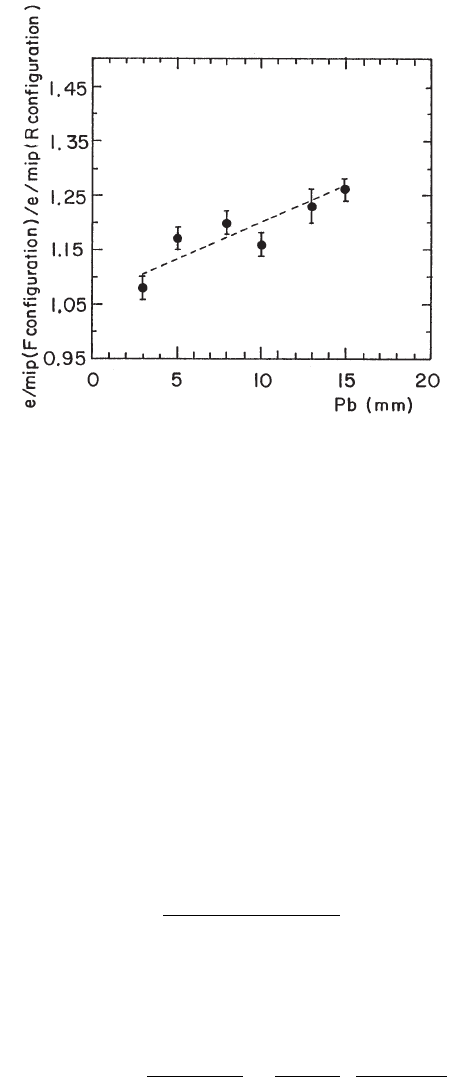
January 9, 2009 10:21 World Scientific Book - 9.75in x 6.5in ws-bo ok975x65˙n˙2nd˙Ed
638 Principles of Radiation Interaction in Matter and Detection
Fig. 9.11 Ratio of e/mip values of F- to R-configuration for passive samplers made of Fe and Pb
absobers, as a function of Pb absorber thickness (from [Leroy and Rancoita (2000)]). The line is
to guide the eye.
Results obtained with 30 mm thick passive samplers ([SICAPO Collab. (1993b)]
and Sect. 9.3.1) can be compared with results obtained, when plexiglas layers
(1.6 mm in front and 0.8 mm behind every active plane of silicon detectors) are
inserted in R- and F-configurations. The ratio between e/mip values, of the electro-
magnetic visible-energy measured in F- to R-configurations modified by the insertion
of plexiglas plates, increases from 1.17 ±0.02 up to 1.29 ±0.02 and is similar to the
ratio shown in Fig. 9.10 when no plexiglas layer was inserted in similar configura-
tions.
However, the overall change in the electron visible-energy is best observed (and
shown in Table 9.2) when the energy ²
vis
(R + P) deposited in R-configurations,
for the 3 mm thick passive sampler in which plexiglas layers [(1.6 + 0.8) mm]
are inserted, is compared with the energy ²
vis
(F) deposited in corresponding F-
configurations (with no plexiglas layer). The value of
D ≡
²
vis
(F) − ²
vis
(R + P)
²
vis
(R + P)
(9.17)
is as large as (41.0 ± 1.0)% for 15 mm of Fe and 15 mm of Pb in the passive sam-
pler. Taking into account that from Eq. (9.17) ²
vis
(R + P) = ²
vis
(F)/ (1 + D), the
ratio e/mip(R + P) with plexiglas layers and 15 mm Pb +15 mm Fe absorbers (R+P
configuration) is given by
e/mip(R + P) =
²
vis
(R + P)
E
s
(R + P)
=
²
vis
(F)
(1 + D)
·
1
E
s
(R + P)
¸
. (9.18)

January 9, 2009 10:21 World Scientific Book - 9.75in x 6.5in ws-bo ok975x65˙n˙2nd˙Ed
Principles of Particle Energy Determination 639
Table 9.2 Pb thickness versus the ratio D ≡ [²
vis
(F) − ²
vis
(R + P)]/²
vis
(R + P) in
percentage, where ²
vis
(R + P) is the energy deposited in the R-configurations for the
30 thick samplers and plexiglas layers [(1.6 + 0.8) mm], ²
vis
(F) is the corresponding
energy deposited in F-configurations (with no Plexiglas) from [Leroy and Rancoita
(2000)].
Pb thickness (mm) Ratio D (%)
5 32.9±1.0
10 34.1±1.0
15 41.0±1.0
Since D is ≈ 41%, and E
s
(R + P) only ≈ 1.2% lower than E
s
(R) = E
s
(F) (namely
the E
s
value for the F- and R-configuration for 15 mm Fe and 15 mm Pb absorbers),
the final result is:
e/mip(R + P) ≈
²
vis
(F)
E
s
(F)
·
1
(1 + D)
¸
≈ 0.71 e/mip(F). (9.19)
As discussed in Sect. 9.2.3, the insertion of low-Z plates (like polyethylene, plexi-
glas, aluminium, G10 plates or others) leads to similar effects when these absorbers
are inserted in between the thick passive sampler and the readout detector.
A large e/mip ratio reduction, of about 18%, was obtained by combining the
two effects in a calorimeter with plastic scintillator active samplers, and Pb and Fe
passive absorbers [Beretvas et al. (1993)]. In this case the local hardening effect was
achieved by inserting low-Z plates in front of and behind the active media, i.e., by
cladding the scintillator with 1.6 mm thick aluminum sheets [Beretvas et al. (1993)].
The possible use of polyethylene, a hydrogen-rich material, to achieve the tu-
ning of the e/mip ratio presents the advantage that it plays the role of a neutron
moderator, as indicated by activation studies in [SICAPO Collab. (1991d)], and
may then contribute to reinforcing the radiation hardness of calorimeters, whose
readout detectors are not too sensitive to very slow neutrons.
A further increase of the calorimeter radiation hardness is obtained, when low
(or medium) Z absorbers, like Fe, are employed as passive samplers. In fact (see
Sect. 3.3 on Hadronic Shower Development and Propagation in Matter), during the
hadronic cascading process, fewer neutrons are generated in low-A (which are also
low-Z) materials than in high-A (which are also high-Z) materials.
Indeed experiments at the LHC collider, for instance, will face an environment
of high-level radiation challenging the survival of the calorimeters. The neutrons
with fluences estimated to reach up between 10
12
and 10
13
cm
−2
year
−1
are at the
core of the problem. The large cross section of neutrons on hydrogen nuclei suggests
introducing hydrogeneous material in calorimeters, in order to moderate the effect of
neutrons and reduce the damage inflicted by neutrons on the calorimeter materials
and equipment, esp ecially the detectors and their readout electronics. Preliminary
results were reported on experiments involving the exposure to very intense beams
at the CERN PS of Na, In, and Rh foils, with and without polyethylene foils in a
dump calorimeter [SICAPO Collab. (1991d)]. These results indicate that the low-
energy neutron flux should be reduced by as much as an order of magnitude with
